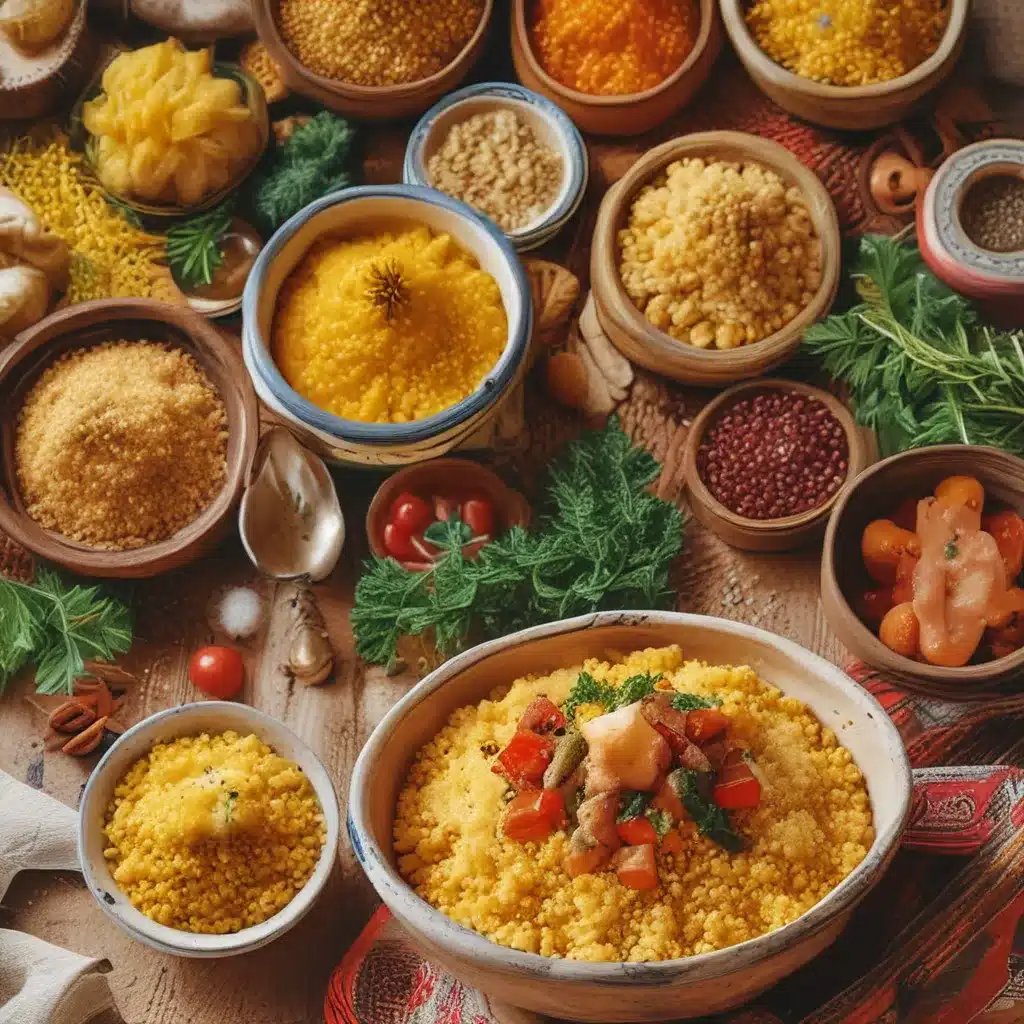
The Humble Origins of a Moroccan Icon
As the child of two strict Moroccan foodies, my experience with couscous growing up was nothing short of traditional. Couscous was never just a side dish or a salad – it was the main event, a communal feast that brought family and friends together on the holy day of Friday.
You see, in Morocco, the term “couscous” refers to the entire dish – the steamed semolina granules served with a delectable broth and an array of meat, vegetables, and spices. It’s a foundational element of Moroccan cuisine, a tradition that has been passed down for over 2,000 years.
The Berber Beginnings of Couscous
While the exact origins of couscous are shrouded in mystery, many historians agree that it emerged in North Africa with the Berber people, the indigenous inhabitants of the region. These ingenious cooks are responsible for not only the couscous we know and love, but also the iconic tagine pot and the slow-cooking methods that define Moroccan cuisine.
According to my Moroccan food blog, the word “couscous” actually comes from the Berber word “keskas,” which refers to the utensil used to steam the semolina granules. The Berbers were masters of this labor-intensive process, hand-rolling the semolina flour and water into tiny pellets, then steaming them to perfection.
But couscous isn’t just a Moroccan staple – it’s a beloved dish across North Africa. As the Washington Post explains, the dish is so integral to the region that Algeria, Mauritania, Morocco, and Tunisia even submitted a joint bid for couscous to receive UNESCO’s Intangible Cultural Heritage status, a prestigious honor reserved for the world’s most cherished cultural practices.
Couscous: A Culinary Chameleon
While the basic premise of couscous remains the same across North Africa – steamed semolina granules topped with a flavorful stew – each country and even each family has their own unique spin on this cultural icon. In Morocco, the classic version is the “7 Vegetables Couscous with Meat,” a hearty dish that showcases the vibrant flavors of the region.
But couscous isn’t just a savory staple – it can also shine as a dessert. In Libya, for example, couscous is often prepared with dates, sesame, and pure honey, creating a dish known as “maghrood.” And in Malta, a slightly larger version of couscous, called “kusksu,” is commonly used in a dish that includes broad beans and a local cheese.
The versatility of couscous is truly astounding, and it’s a testament to the creativity and ingenuity of North African cooks. Whether it’s a savory stew or a sweet treat, couscous is always a delicious celebration of the region’s rich culinary heritage.
The Evolution of Couscous
As with any beloved cultural tradition, couscous has evolved over the centuries, adapting to new influences and technologies. According to Wikipedia, the traditional hand-rolling process used by the Berbers has largely been replaced by mechanized production, making couscous more accessible to the masses.
And while purists may turn their noses up at the idea of “instant” couscous, the convenience of this pre-steamed and dried version has undoubtedly helped to spread the love of this Moroccan staple around the world. As my Moroccan food blog notes, even I’m guilty of breaking from tradition and whipping up a quick batch of instant couscous when I’m short on time.
But no matter how couscous is made, the essence of the dish remains the same – a delightful harmony of textures and flavors that transports you to the vibrant streets of Marrakech or the sun-drenched beaches of Essaouira. And for me, that’s the true magic of couscous, a culinary treasure that has stood the test of time and continues to captivate palates around the globe.
The Couscous Conundrum
As I was researching the history and significance of couscous, I stumbled upon a curious conundrum: where exactly does this versatile dish fit in the culinary landscape? Is it a grain? A pasta? Something in between?
The Washington Post delved into this perplexing question, exploring the various ways couscous has been described – from “tiny pasta” to “grain-like pasta” to “processed wheat.” And you know what? They’re all kind of right.
Couscous is a unique culinary creation that defies simple classification. It’s made from semolina, the same coarsely ground durum wheat used in pasta, but it’s not extruded or kneaded like traditional pasta. Instead, it’s hand-rolled into those delightful little pellets, a process that sets it apart from its pasta cousins.
So while couscous may share some similarities with grains and pastas, it’s truly in a league of its own. And that’s what makes it so special – it’s a culinary chameleon, a versatile ingredient that can be transformed into everything from a hearty main dish to a sweet dessert.
Couscous: The Moroccan Treasure
As I sit here, salivating at the mere thought of a fragrant bowl of couscous, I can’t help but feel a deep sense of appreciation for this Moroccan treasure. It’s not just a dish – it’s a cultural touchstone, a tradition that has endured for millennia and continues to bring people together, both in Morocco and around the world.
Whether you’re savoring a steaming plate of 7 Vegetables Couscous with Meat or indulging in a decadent Maghrood dessert, couscous has a way of transporting you to the vibrant heart of Moroccan cuisine. And for me, that’s the true beauty of this humble grain-pasta-hybrid – it’s a culinary ambassador, a delicious link between cultures and generations.
So the next time you find yourself craving a taste of Morocco, I invite you to visit my family’s Moroccan restaurant in New York City. We may not be able to transport you to the bustling streets of Marrakech, but we can certainly serve up a heaping helping of couscous that will make you feel like you’re there.


